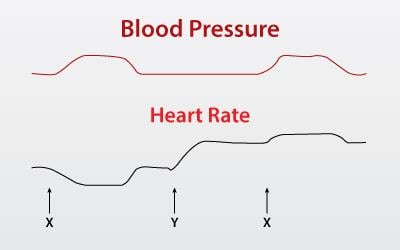The United States Medical Licensing Examination® (USMLE®) Step 1 exam is notorious for pushing the limits of medical students’ knowledge, so you might like to know which test prep questions are commonly missed. Check out this month’s question that Kaplan Medical says stumps most students, and view an expert video explanation of the answer. See all posts in this series.
Think you have what it takes to rise above your peers? Test your USMLE knowledge below.
Ready. Set. Go.
This month’s question that stumped most students
The diagram shows changes in blood pressure and heart rate in an animal with intact reflexes in response to drug X (agonist) and drug Y (antagonist). Assume that the antagonist's effects will last for the duration of the experiment and that the agonist's effects are transient. Drug X and drug Y are most likely to be which of the following?
A. X=Isoproterenol/Y=Atropine
B. X=Isoproterenol/Y=Phentolamine
C. X=Isoproterenol/Y=Propranolol
D. X=Norepinephrine/Y=Atropine
E. X=Norepinephrine/Y=Phentolamine
F. X=Norepinephrine/Y=Propranolol
The correct answer is D. A good approach for such questions is the process of elimination.
Kaplan Medical explains why
Because the agonist raises arterial blood pressure, it must be a pressor, such as norepinephrine (NE). Isoproterenol, a beta agonist, would cause a decrease in blood pressure by vasodilation; therefore, choices A, B, and C can be immediately eliminated. The decrease in heart rate is due to a baroreceptor reflex. The increased blood pressure leads to increased parasympathetic and decreased sympathetic tone to the heart.
The next step is to see if any antagonists can be eliminated. Drug Y alone causes no change in blood pressure but an increase in heart rate. Phentolamine (choice E), an alpha antagonist, can be eliminated because this should decrease blood pressure by blocking sympathetic tone to arterioles. Propranolol (choice F), a beta antagonist, would be expected to cause a small decrease in blood pressure and a decrease in heart rate. So choices E and F can be eliminated.
Every option except choice D has been eliminated, but working through choice D would still be a good idea. Atropine blocks muscarinic receptors, but has virtually no effect on blood pressure because the muscarinic receptors in the vasculature (M3 receptors) are not innervated and therefore have no tone. However, blocking M2 receptors on the SA node results in an increase in heart rate due to the removal of the dominant parasympathetic tone that normally slows the heart.
Administration of NE after atropine would still lead to the alpha-1 receptor-mediated vasoconstriction, thus increasing blood pressure. However, because atropine is still blocking muscarinic receptors in the SA node when NE is administered the second time, there is no slowing of the heart rate because it was primarily mediated by increased parasympathetic activity. Therefore the direct beta-1 adrenergic effects of NE on the SA are unopposed and the heart rate increases. This is consistent with the drug trace in the question.
One key tip to remember
When looking at drug traces, always think about blood pressure first and then heart rate second. Changes in blood pressure will be due to a direct effect on blood vessels and changes in heart rate may be due to either a baroreceptor effect or a direct effect on the heart.





